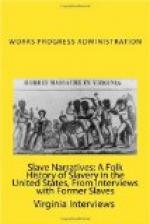“If any of them got anything in Virginia, I don’t know anything about it. They might have been some slaves that did get something—just like they was here in Arkansas.
“Old Man Wilfong, when he freed Andy Wilfong in Bradley County, Arkansas, gave Andy plenty. He did get forty acres of land. That is right down here out from Warren. Wilfong owned that land and a heap more when he died. He hasn’t been dead more than six or seven years. I pastored him in 1904 and 1905. There were others who expected to get something, but I don’t know any others that got it. Land was cheap then. Andy bought land at twenty-five and fifty cents an acre, and sold the timber off of it at the rate of one thousand dollars for each forty acres. He bought hundreds of acres. He owned a section and a section and one-half of land when he was my member. He had seven boys and two girls and he gave them all forty acres apiece when they married. Then he sold the timber off of four forties. Whenever a boy or girl was married he’d give him a house. He’d tell him to go out and pick himself out a place.
“He sold one hundred and sixty acres of timber for four thousand dollars, but if he had kept it for two years longer, he would have got ten thousand dollars for it. The Bradley Lumber Company went in there and cut the timber all through.
“Wilfong’s master’s name was Andrew Wilfong, same as Andy’s. His master came from Georgia, but he was living in Arkansas when freedom came. Later on Andy bought the farm his master was living on when freedom came. His master was then dead.
Right After the War
“My mother came back home and we went on farming just like we did before, raising stuff to eat. You know I can’t remember much that they did before the War but I can remember what they did during the War and after the War,—when they came back home. My folks still own the old place but I have been away from there sixty-one years. A whole generation has been raised up and died since I left.
“I came out with one of my cousins and went to Georgia (Du Pont) following turpentine work. It was turpentine farming. You could cut a hole in the tree known as the box. It will hold a quart. Rosin runs out of that tree into the box. Once a week, they go by and chip a tree to keep the rosin running. Then the dippers dip the rosin out and put it in barrels. Them barrels is hauled to the still. Then it is distilled just like whiskey would be. The evaporation of it makes turpentine; the rosin is barreled and shipped to make glass. The turpentine is barreled and sold. I have dipped thousands of gallons of turpentine.
“I came to South Carolina in 1880 and married. I stayed there seven years and came to Arkansas in 1888. I came right to North Little Rock and then moved out into the country around Lonoke County,—on a farm. I farmed there for five years. Then I went to pastoring. I started pastoring one year before I quit making cotton. I entered the ministry in 1892 and continued in the active service until November 1937. I put in forty-five years in the active ministry.




